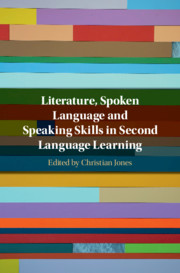Book contents
- Literature, Spoken Language and Speaking Skills in Second Language Learning
- Literature, Spoken Language and Speaking Skills in Second Language Learning
- Copyright page
- Contents
- Figures and Tables
- Contributors
- Foreword
- Acknowledgements
- 1 Introduction
- Part I Literature and Spoken Language
- 2 The Realism of Conversation in Literature
- 3 Using Literature in Text-Driven Materials to Help Develop Spoken Language Awareness
- 4 Literature, TV Drama and Spoken Language Awareness
- 5 Haiku and Spoken Language: Corpus-Driven Analyses of Linguistic Features in English Language Haiku Writing
- 6 Screenplays as a Pedagogical Medium for Cultivating EFL Learners’ Metapragmatic Awareness of Speech Acts in Spoken English
- Part II Literature and Speaking Skills
- Index
- References
2 - The Realism of Conversation in Literature
from Part I - Literature and Spoken Language
Published online by Cambridge University Press: 18 October 2019
- Literature, Spoken Language and Speaking Skills in Second Language Learning
- Literature, Spoken Language and Speaking Skills in Second Language Learning
- Copyright page
- Contents
- Figures and Tables
- Contributors
- Foreword
- Acknowledgements
- 1 Introduction
- Part I Literature and Spoken Language
- 2 The Realism of Conversation in Literature
- 3 Using Literature in Text-Driven Materials to Help Develop Spoken Language Awareness
- 4 Literature, TV Drama and Spoken Language Awareness
- 5 Haiku and Spoken Language: Corpus-Driven Analyses of Linguistic Features in English Language Haiku Writing
- 6 Screenplays as a Pedagogical Medium for Cultivating EFL Learners’ Metapragmatic Awareness of Speech Acts in Spoken English
- Part II Literature and Speaking Skills
- Index
- References
Summary
This chapter analyses conversations from a corpus of literature in order to uncover the extent to which these conversations contain typical features of spoken language, such as vague language and discourse markers. Such features have long been identified as key features of spoken language in corpora based on unscripted conversations (Carter and McCarthy ). The extent to which naturally occurring spoken language is similar to and different from literary conversations has been researched within the field of stylistics (e.g. Hughes ; Semino and Short ), but the extent to which conversations in literature could provide a useful model for learners of English as a Foreign Language and English as a Second Language (EFL/ESL) is less clear. Drawing upon corpus data from the CLiC Dickens corpus (Mahlberg et al. ) and the BYU-BNC spoken corpus (Davies ), this chapter seeks to explore how often common features occur and whether the frequency of occurrence is significant in comparison to data from unscripted conversations. We also explore the data qualitatively to examine whether the functions of common spoken language features differ or are similar. In doing so, we hope to uncover the extent to which conversations in literature can offer a plausible model of spoken English for EFL or ESL learners.
- Type
- Chapter
- Information
- Publisher: Cambridge University PressPrint publication year: 2019



